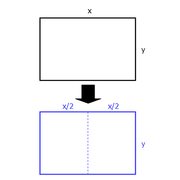Quote:
A project requires a rectangular sheet of cardboard satisfying the following requirement: When the sheet is cut into identical rectangular halves, each of the resulting rectangles has the same ratio of length to width as the original sheet. Which of the following sheets comes closest to satisfying the requirement?
(A) A sheet measuring 7 inches by 10 inches
(B) A sheet measuring 8 inches by 14 inches
(C) A sheet measuring 10 inches by 13 inches
(D) A sheet measuring 3 feet by 5 feet
(E) A sheet measuring 5 feet by 8 feet
Official Explanation:There are two possible approaches to this problem: algebra and working backwards from the answer choices. Both solutions are given below.
Algebraic Solution:Say the original sheet measures L by W, with L > W, so that the cut yields two rectangular halves measuring L/2 by W each.
Per the project requirements, the ratio of these new dimensions must be the same as the ratio of L to W. Consider both possible ways in which the ratio might be set up. If the ratio of original to new is set up as L : W = L/2 : W, then it reduces to 1 = 1/2, an impossible condition. (Or, if you prefer to reason theoretically, it is impossible to reduce L by half but leave W unchanged and have the ratio stay the same.)
Therefore, the width (W) of the original rectangle, must become the longer side for the smaller rectangles. The ratio must be set up as L : W = W : L/2.
Set up the ratio:
W/\(\frac{L}{2}\)=\(\frac{L}{W}\)
\(W^2\)=\(\frac{L^2}{2}\)
\(2W^2=L^2\)
\(W√2=L\)
The condition thus requires original dimensions that come as close as possible to satisfying \(W√2=L\), or, equivalently,\(\frac{L}{W}=√2\).
The square root of 2 is approximately 1.4 (if you don’t already have this memorized, memorize it right now!). The answer choices represent the size of the original sheet (before being cut); call the larger dimension L and the smaller one W. Use the answer choices to calculate an approximate value for L/W. The one closest to 1.4 is the correct answer.
(A) 10/7 = approximately 1.4
(B) 14/8 = 7/4 = 1.75
(C) 13/10 = 1.3
(D) 5/3 = approximately 1.7
(E) 8/5 = 1.6
Choice A comes closest to the requirement.
The correct answer is (A).
Working Backwards:As shown at the beginning of the algebraic solution, when the paper is cut in half, what used to be the width becomes the length of the smaller rectangles. In other words, in order for the original ratio to equal the new one, \(L : W = W : \frac{L}{2.}\)
Starting from the answer choices, test the requirement directly. First, find the ratio of the original dimensions (\(\frac{L}{W}\)). Then, find the ratio of the dimensions after one dimension (the longer one) is cut in half; this will be W/\(\frac{L}{2}\). The correct answer is the choice for which the two ratios are closest to being equal.
(A) The original ratio is 10/7. Half of 10 is 5, so the new dimensions are 7 and 5. The ratio for each smaller rectangle is 7/5 = 14/10. (Remember to use the larger number as the numerator, as you did in the original ratio.) Find a common denominator to compare the ratios: 100/70 and 98/70. Pretty close!
(B) The original ratio is 14/8. Half of 14 is 7, so the ratio for each smaller rectangle is 8/7. Find a common denominator to compare the ratios (but make your life easier: simplify 14/8 to 7/4): 49/28 and 32/28. These are not as close as the ratios in answer (A), so eliminate (B).
(C) The original ratio is 13/10. Half of 13 is 6.5, so the ratio for each smaller rectangle is 10/6.5 = 20/13. Find a common denominator to compare the ratios: 169/130 and 200/130. These are not as close as the ratios in answer (A), so eliminate (C).
(D) The original ratio is 5/3. Half of 5 is 2.5, so the ratio for each smaller rectangle is 3/2.5 = 6/5. Find a common denominator to compare the ratios: 25/15 and 18/15. These are not as close as the ratios in answer (A), so eliminate (D).
(E) The original ratio is 8/5. Half of 8 is 4, so the ratio for each smaller rectangle is 5/4. Find a common denominator to compare the ratios: 32/20 and 25/20. These are not as close as the ratios in answer (A), so eliminate (E).
The correct answer is (A).




 95%
(hard)
95%
(hard)
 67%
(02:25)
wrong
67%
(02:25)
wrong  based on 601
sessions
based on 601
sessions







